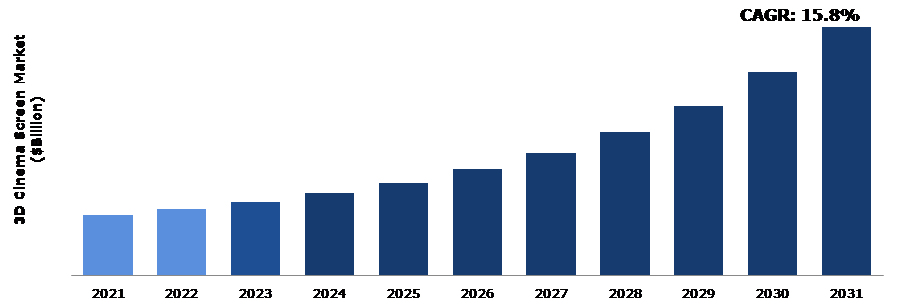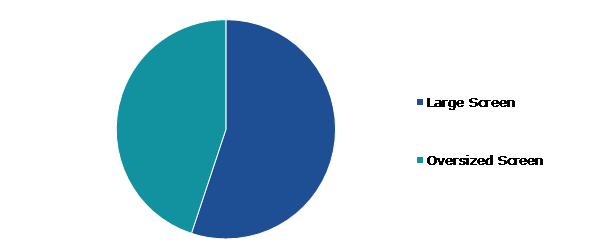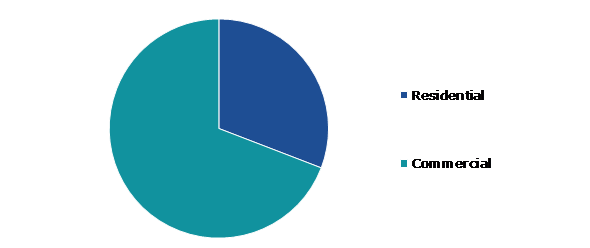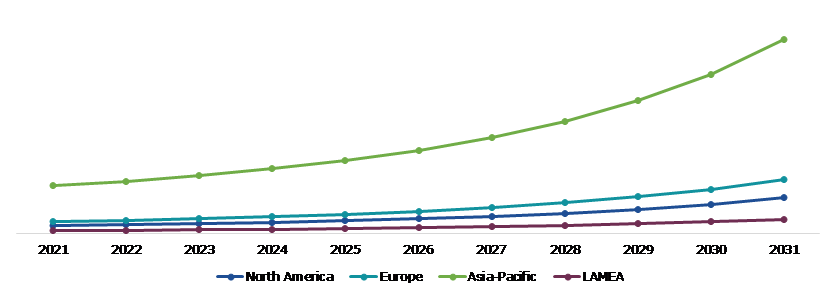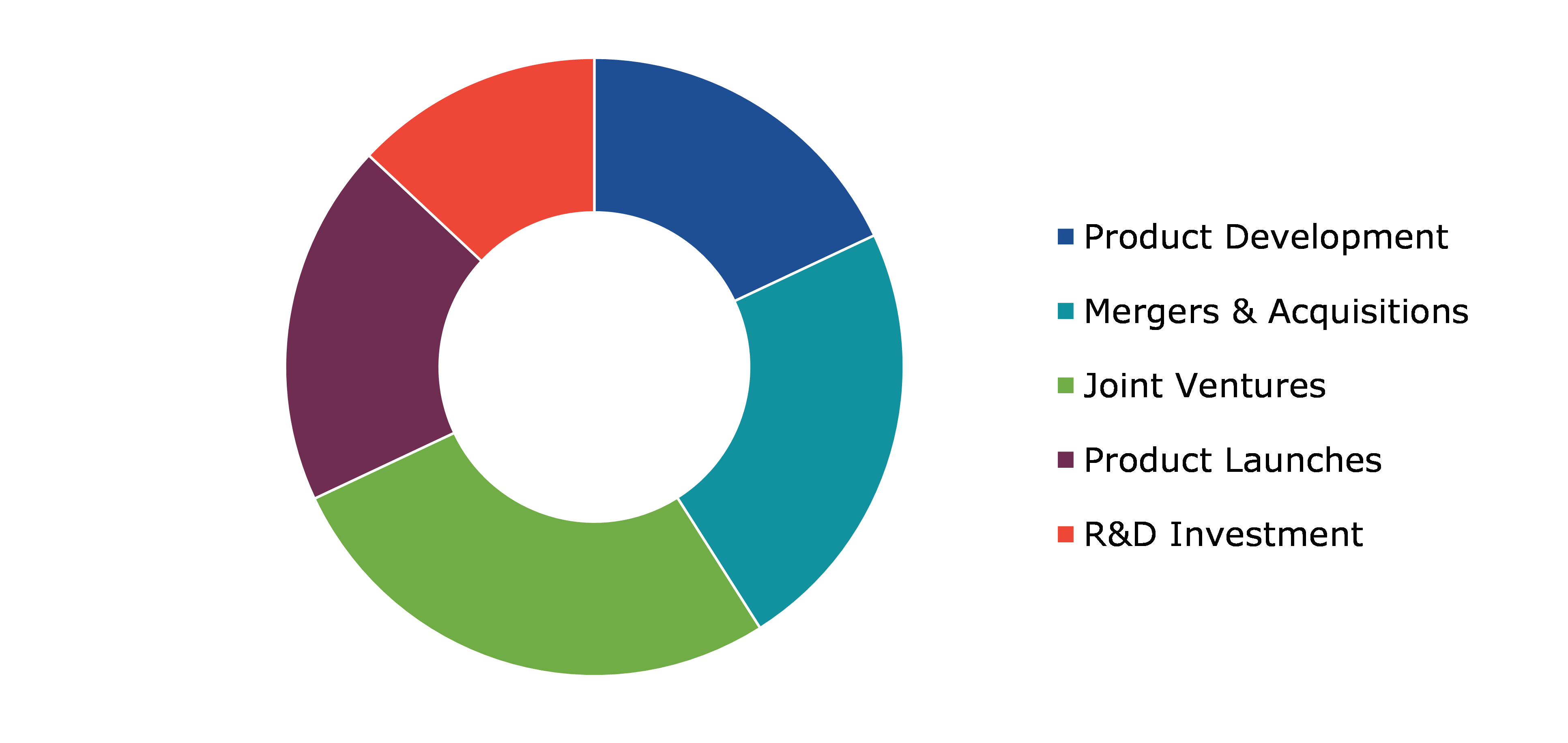3D Cinema Screen Market Report
RA08616
3D Cinema Screen Market by Type (Large Screen and Oversized Screen), Application (Residential and Commercial), and Regional Analysis (North America, Europe, Asia-Pacific, and LAMEA): Global Opportunity Analysis and Industry Forecast, 2022-2031
Global 3D Cinema Screen Market Analysis
The Global 3D Cinema Screen Market Size was $132.7 million in 2021 and is predicted to grow with a CAGR of 15.8%, by generating a revenue of $548.3 million by 2031.
Global 3D Cinema Screen Market Synopsis
The rise of video games and other interactive experiences has increased demand for 3D cinema screens that can provide a more dynamic and engaging experience. Movie theaters and other entertainment venues are now looking for screens that can provide an immersive, multi-sensory experience that can be enjoyed by all age groups. Moreover, the growth of the gaming industry is also contributing to the growth of the 3D cinema screen market. Many video games now offer 3D graphics and visuals, making the gaming experience more immersive and realistic. This has led to a growing demand for 3D cinema screens that can provide a more vivid and immersive gaming experience. The increase in the adoption of virtual reality and the growth of the interactive entertainment and gaming industries are driving the demand for 3D cinema screens. With technology advancements, these screens are becoming more affordable and accessible, making them an attractive option for movie theaters and other entertainment venues. These factors are anticipated to boost the 3D cinema screen market growth in the upcoming years.
However, one of the industry's leading companies, Samsung, cautioned viewers that 3D TV might cause epileptic convulsions and even strokes. Another electronics company, Nvidia, also provides warnings about the consequences of 3D. Unsubstantiated claims have also been made that 3D may have negative impacts on the eyesight of children, teenagers, and the elderly. These factors are expected to hamper the market revenue growth during the forecast period.
The market is expected to continue growing in the coming years as more cinemas are incorporating 3D technology into their screens to meet the demand for a more engaging and interactive movie-watching experience. The trend towards large-scale 3D movies has also boosted the demand for 3D cinema screens, which have a larger screen size and more advanced technology than regular 2D screens. Moreover, the advent of more sophisticated 3D projection systems has led to an increase in the number of 3D movies being produced, further fueling the growth of the 3D cinema screen market. The increase in the number of 3D movies also leads to an increase in revenue for cinemas that invest in 3D screens, as moviegoers are willing to pay a premium for the immersive experience. The growth of the market presents a significant opportunity for manufacturers, suppliers, and distributors of 3D cinema screens.
According to regional analysis, the Asia-Pacific 3D cinema screen market accounted for the highest market share in 2021. The growing popularity of 3D movies, rising disposable income, and the increasing demand for an immersive movie-watching experience are the key factors driving the growth of the 3D cinema screen market in this region. Countries such as China, India, Japan, South Korea, and Australia have witnessed rapid growth in the number of 3D cinema screens, as movie-goers in these countries have shown a keen interest in watching 3D movies.
3D Cinema Screen Overview
The 3D cinema screen market has grown significantly in recent years owing to the increase in demand for high-quality movies with upgraded VFX technology that provides clients with a superior virtual reality experience. Depth sensors, 3D displays, polarized glasses, and visual effects (VFX) photography are all being used to improve the movie experience for spectators. Furthermore, the use of digital projection systems to display high-definition motion films using 3D technologies tends to boost the expansion of the 3D cinema screen market.
COVID-19 Impact on the Global 3D Cinema Screen Market
The COVID-19 pandemic has brought several uncertainties leading to severe economic losses as various businesses across the world were standstill. The COVID-19 pandemic has had a significant impact on the 3D cinema screen market. With the widespread shutdown of cinemas worldwide due to the pandemic, there has been a decrease in the demand for 3D cinema screens, as well as a decrease in the production and installation of new screens. Furthermore, the pandemic has shifted consumer preferences towards home entertainment, with many people opting to watch movies and TV shows at home instead of going to the cinema. This has resulted in a decrease in the demand for 3D cinema screens, as people are less likely to watch 3D movies in their homes. Moreover, the pandemic has also affected the supply chain of 3D cinema screens, with disruptions in the production and delivery of components and raw materials, leading to delays and higher costs. However, it is expected that the 3D cinema screen market will recover in the long term, as people are now returning to cinemas. Nevertheless, the industry may take some time to regain its pre-pandemic levels, as consumer habits and preferences may have changed.
Growing Demand for 3D Cinema Screens and Advancement in Technology to drive the Market Growth
The advancements in technology have led to the development of new and improved 3D cinema screen technologies, such as auto-stereoscopic displays, which do not require the use of 3D glasses, and high-resolution displays, which provide a more vivid and lifelike image quality. The increase in the availability of affordable 3D content and the growing popularity of virtual reality and augmented reality experiences have also fueled the demand for 3D cinema screens. Furthermore, the growth of the entertainment industry and the increase in popularity of theme parks, amusement parks, and other forms of entertainment that use 3D cinema screens as an attraction is also expected to drive the growth of the 3D cinema screen market during the forecast period.
To know more about global 3D cinema screen market drivers, get in touch with our analysts here.
Limitations of High Cost and the Health Risks to Restrain the Market Growth
The cost of upgrading to a 3D cinema screen involves a high investment in the installation of special equipment, including 3D projectors, 3D glasses, and specialized sound systems. People who have inherited color blindness or are unable to do binocular fusion cannot view 3D displays. In addition, continuously watching 3D screens can majorly result in headaches or eye infections. The additional costs associated with showing 3D films, such as higher licensing fees, further add to the expenses. This can limit the ability of small-budget theaters to offer 3D films and can make it difficult for them to compete with larger, more well-funded theaters. Therefore, the high cost of 3D cinema screens is anticipated to limit the growth and expansion of the 3D cinema screen market growth.
Increase Adoption of Digital Projection Technology in 3D Cinema Screens to Drive Excellent Opportunities
Digital projection technology has improved the overall cinema experience by providing brighter, clearer images, and greater color accuracy. It has also made it easier for theaters to upgrade to 3D capabilities. The integration of 3D technology with digital projection has made it easier and more affordable for theaters to offer 3D movies, which has resulted in a growing demand for 3D cinema screens. Moreover, the increase in popularity of 3D movies, along with advancements in 3D technology, has led to the growth of the 3D cinema screen market. The growing adoption of digital projection technology and the increasing popularity of 3D movies present a significant opportunity for the 3D cinema screen market. The advancements in 3D technology and the growing demand for 3D cinema screens are expected to drive the growth of the market, making it an attractive investment opportunity for manufacturers and investors. All these factors are predicted to create several growth opportunities for the key players operating in the market during the forecast period.
To know more about global 3D cinema screen market opportunities, get in touch with our analysts here.
Global 3D Cinema Screen Market, by Type
Based on type, the market has been divided into large screen and oversized screen. Among these, the large screen sub-segment accounted for the highest market share in 2021, whereas the oversized screen sub-segment is estimated to show the fastest growth during the forecast period.
Global 3D Cinema Screen Market Size, by Type, 2021
Source: Research Dive Analysis
The large screen sub-segment accounted for the dominant market share in 2021. A large screen is a type of display that is designed for use in a theatre, conference room, or another similar setting. The biggest screens now accessible are in IMAX theatres, with an aspect ratio (or width/height) of around 20:11 and dimensions of 22 m 17.77 m (72 ft 58 ft). They can be fixed-frame screens like those used in traditional movie theatres, which conceal the projector equipment behind the screen, or integrated projection systems.
The oversized screen sub-segment is anticipated to witness the fastest growth in 2031. An oversized screen is a film or video projector that displays pictures that are bigger and more detailed than standard-sized screens. Oversized projectors can be used in theatres, conference rooms, auditoriums, stadiums, museums, and other big locations. They have the apparent benefit of having a far widescreen range as well as superior image clarity due to their higher resolution capabilities.
Global 3D Cinema Screen Market, by Application
Based on application, the market has been divided into residential and commercial. Among these, the commercial sub-segment accounted for the highest revenue share in 2021.
Global 3D Cinema Screen Market Share, by Application, 2021
Source: Research Dive Analysis
The commercial sub-segment accounted for a dominant market share in 2021. Large-screen displays are used in commercial applications such as airports, retail malls, and other public venues. The oversized screen is widely used in commercial applications such as in airports, and shopping malls to display advertisements in 3D format. For instance, major brands throughout the world have welcomed 3D digital displays, particularly because they give perspective and depth to their marketing and promotion channels. These factors are anticipated to boost the growth of the commercial sub-segment during the forecast timeframe.
Global 3D Cinema Screen Market, Regional Insights
The 3D cinema screen market was investigated across North America, Europe, Asia-Pacific, and LAMEA.
Global 3D Cinema Screen Market Size & Forecast, by Region, 2021-2031 ($Million)
Source: Research Dive Analysis
The Market for 3D Cinema Screen in Asia-Pacific to be the Most Dominant
The Asia-Pacific 3D cinema screen market is anticipated to register the highest market share in 2031. The Asia-Pacific region has witnessed significant growth in the 3D cinema screen market in recent years. The growing popularity of 3D movies, rising disposable income, and the increasing demand for an immersive movie-watching experience are the key factors driving the growth of the 3D cinema screen market in this region. Countries such as China, India, Japan, South Korea, and Australia have witnessed rapid growth in the number of 3D cinema screens, as movie-goers in these countries have shown a keen interest in watching 3D movies. Furthermore, the expansion of multiplex chains in these countries has also played a crucial role in the growth of the 3D cinema screen market in the Asia-Pacific region. Furthermore, the increasing adoption of advanced technologies such as virtual reality and augmented reality in the movie-watching experience is also contributing to the growth of the 3D cinema screen market in the region. Asia-Pacific is expected to continue to grow in the upcoming years, due to the increase in demand for 3D movies and the rise in popularity of 3D cinema screens. These investments are expected to have a beneficial influence on the growth of the regional 3D cinema screen market during the projected period.
Competitive Scenario in the Global 3D Cinema Screen Market
Investment and agreement are common strategies followed by major market players. For instance, AMC established a 3D movie theatre in June 2021 and raised almost $2 billion in the previous six months, with plans to utilize part of the additional capital to buy other theatre sites. This will boost the number of 3D movie theatres, driving the market development even further.
Source: Research Dive Analysis
Some of the leading 3D cinema screen market players are Harkness Screen, Galalite Screens, EKRAN, Severtson Screen, Samsung, Ballantyne Strong, IMAX, Sony, and RealID Inc.
| Aspect | Particulars |
| Historical Market Estimations | 2020 |
| Base Year for Market Estimation | 2021 |
| Forecast Timeline for Market Projection | 2022-2031 |
| Geographical Scope | North America, Europe, Asia-Pacific, and LAMEA |
| Segmentation by Type |
|
| Segmentation by Application |
|
| Key Companies Profiled |
|
Q1. What is the size of the global 3D cinema screen market?
A. The size of the global 3D cinema screen market was over $132.7 million in 2021 and is projected to reach $548.3 million by 2031.
Q2. Which are the major companies in the 3D cinema screen market?
A. Harkness Screen, Galalite Screens, and EKRAN are some of the key players in the global 3D cinema screen market.
Q3. Which region, among others, possesses greater investment opportunities in the future?
A. Asia-Pacific possesses great investment opportunities for investors in the future.
Q4. What will be the growth rate of the Asia-Pacific 3D cinema screen market?
A. Asia-Pacific 3D cinema screen market is anticipated to grow at 15.6% CAGR during the forecast period.
Q5. What are the strategies opted by the leading players in this market?
A. Agreement and investment are the two key strategies opted by the operating companies in this market.
Q6. Which companies are investing more on R&D practices?
A. Samsung, IMAX, and Sony are the companies investing more on R&D activities for developing new products and technologies.
1.Research Methodology
1.1.Desk Research
1.2.Real time insights and validation
1.3.Forecast model
1.4.Assumptions and forecast parameters
1.5.Market size estimation
1.5.1.Top-down approach
1.5.2.Bottom-up approach
2.Report Scope
2.1.Market definition
2.2.Key objectives of the study
2.3.Report overview
2.4.Market segmentation
2.5.Overview of the impact of COVID-19 on Global 3D Cinema Screen Market
3.Executive Summary
4.Market Overview
4.1.Introduction
4.2.Growth impact forces
4.2.1.Drivers
4.2.2.Restraints
4.2.3.Opportunities
4.3.Market value chain analysis
4.3.1.List of raw material suppliers
4.3.2.List of manufacturers
4.3.3.List of distributors
4.4.Innovation & sustainability matrices
4.4.1.Technology matrix
4.4.2.Regulatory matrix
4.5.Porter’s five forces analysis
4.5.1.Bargaining power of suppliers
4.5.2.Bargaining power of consumers
4.5.3.Threat of substitutes
4.5.4.Threat of new entrants
4.5.5.Competitive rivalry intensity
4.6.PESTLE analysis
4.6.1.Political
4.6.2.Economical
4.6.3.Social
4.6.4.Technological
4.6.5.Environmental
4.7.Impact of COVID-19 on 3D Cinema Screen Market
4.7.1.Pre-covid market scenario
4.7.2.Post-covid market scenario
5.3D Cinema Screen Market Analysis, by Type
5.1.Overview
5.2.Large Screen
5.2.1.Definition, key trends, growth factors, and opportunities
5.2.2.Market size analysis, by region
5.2.3.Market share analysis, by country
5.3.Oversized Screen
5.3.1.Definition, key trends, growth factors, and opportunities
5.3.2.Market size analysis, by region
5.3.3.Market share analysis, by country
5.4.Research Dive Exclusive Insights
5.4.1.Market attractiveness
5.4.2.Competition heatmap
6.3D Cinema Screen Market Analysis, by Application
6.1.Residential
6.1.1.Definition, key trends, growth factors, and opportunities
6.1.2.Market size analysis, by region
6.1.3.Market share analysis, by country
6.2.Commercial
6.2.1.Definition, key trends, growth factors, and opportunities
6.2.2.Market size analysis, by region
6.2.3.Market share analysis, by country
6.3.Research Dive Exclusive Insights
6.3.1.Market attractiveness
6.3.2.Competition heatmap
7.3D Cinema Screen Market, by Region
7.1.North America
7.1.1.U.S.
7.1.1.1.Market size analysis, by Type
7.1.1.2.Market size analysis, by Application
7.1.2.Canada
7.1.2.1.Market size analysis, by Type
7.1.2.2.Market size analysis, by Application
7.1.3.Mexico
7.1.3.1.Market size analysis, by Type
7.1.3.2.Market size analysis, by Application
7.1.4.Research Dive Exclusive Insights
7.1.4.1.Market attractiveness
7.1.4.2.Competition heatmap
7.2.Europe
7.2.1.Germany
7.2.1.1.Market size analysis, by Type
7.2.1.2.Market size analysis, by Application
7.2.2.UK
7.2.2.1.Market size analysis, by Type
7.2.2.2.Market size analysis, by Application
7.2.3.France
7.2.3.1.Market size analysis, by Type
7.2.3.2.Market size analysis, by Application
7.2.4.Spain
7.2.4.1.Market size analysis, by Type
7.2.4.2.Market size analysis, by Application
7.2.5.Italy
7.2.5.1.Market size analysis, by Type
7.2.5.2.Market size analysis, by Application
7.2.6.Rest of Europe
7.2.6.1.Market size analysis, by Type
7.2.6.2.Market size analysis, by Application
7.2.7.Research Dive Exclusive Insights
7.2.7.1.Market attractiveness
7.2.7.2.Competition heatmap
7.3.Asia-Pacific
7.3.1.China
7.3.1.1.Market size analysis, by Type
7.3.1.2.Market size analysis, by Application
7.3.2.Japan
7.3.2.1.Market size analysis, by Type
7.3.2.2.Market size analysis, by Application
7.3.3.India
7.3.3.1.Market size analysis, by Type
7.3.3.2.Market size analysis, by Application
7.3.4.Australia
7.3.4.1.Market size analysis, by Type
7.3.4.2.Market size analysis, by Application
7.3.5.South Korea
7.3.5.1.Market size analysis, by Type
7.3.5.2.Market size analysis, by Application
7.3.6.Rest of Asia-Pacific
7.3.6.1.Market size analysis, by Type
7.3.6.2.Market size analysis, by Application
7.3.7.Research Dive Exclusive Insights
7.3.7.1.Market attractiveness
7.3.7.2.Competition heatmap
7.4.LAMEA
7.4.1.Brazil
7.4.1.1.Market size analysis, by Type
7.4.1.2.Market size analysis, by Application
7.4.2.Saudi Arabia
7.4.2.1.Market size analysis, by Type
7.4.2.2.Market size analysis, by Application
7.4.3.UAE
7.4.3.1.Market size analysis, by Type
7.4.3.2.Market size analysis, by Application
7.4.4.South Africa
7.4.4.1.Market size analysis, by Type
7.4.4.2.Market size analysis, by Application
7.4.5.Rest of LAMEA
7.4.5.1.Market size analysis, by Type
7.4.5.2.Market size analysis, by Application
7.4.6.Research Dive Exclusive Insights
7.4.6.1.Market attractiveness
7.4.6.2.Competition heatmap
8.Competitive Landscape
8.1.Top winning strategies, 2021
8.1.1.By strategy
8.1.2.By year
8.2.Strategic overview
8.3.Market share analysis, 2021
9.Company Profiles
9.1.Harkness Screen
9.1.1.Overview
9.1.2.Business segments
9.1.3.Product portfolio
9.1.4.Financial performance
9.1.5.Recent developments
9.1.6.SWOT analysis
9.2.Galalite Screens
9.2.1.Overview
9.2.2.Business segments
9.2.3.Product portfolio
9.2.4.Financial performance
9.2.5.Recent developments
9.2.6.SWOT analysis
9.3.EKRAN
9.3.1.Overview
9.3.2.Business segments
9.3.3.Product portfolio
9.3.4.Financial performance
9.3.5.Recent developments
9.3.6.SWOT analysis
9.4.Severtson Screen
9.4.1.Overview
9.4.2.Business segments
9.4.3.Product portfolio
9.4.4.Financial performance
9.4.5.Recent developments
9.4.6.SWOT analysis
9.5.Samsung
9.5.1.Overview
9.5.2.Business segments
9.5.3.Product portfolio
9.5.4.Financial performance
9.5.5.Recent developments
9.5.6.SWOT analysis
9.6.Ballantyne Strong
9.6.1.Overview
9.6.2.Business segments
9.6.3.Product portfolio
9.6.4.Financial performance
9.6.5.Recent developments
9.6.6.SWOT analysis
9.7.IMAX
9.7.1.Overview
9.7.2.Business segments
9.7.3.Product portfolio
9.7.4.Financial performance
9.7.5.Recent developments
9.7.6.SWOT analysis
9.8.Sony
9.8.1.Overview
9.8.2.Business segments
9.8.3.Product portfolio
9.8.4.Financial performance
9.8.5.Recent developments
9.8.6.SWOT analysis
9.9.RealID Inc.
9.9.1.Overview
9.9.2.Business segments
9.9.3.Product portfolio
9.9.4.Financial performance
9.9.5.Recent developments
9.9.6.SWOT analysis
3D cinema screens, as the name suggests, provide a three-dimensional viewing experience by creating an illusion of three-dimensional solidity. The main advantages of 3D cinema screens over traditional screens include improved image quality and a premium immersive experience for the audience. Though 3D films and screens have been around for a long time since the 1950s, their resurgence is attributed to the use of upgraded VFX technology, polarized glasses, depth sensors, and advanced high-resolution 3D displays.
Forecast Analysis:
In recent years, there has been an increase in penetration of video games and other interactive experiences globally which is predicted to be the primary growth driver of the 3D cinema screen market in the forecast period. Additionally, an increase in the adoption of virtual reality is anticipated to push the market forward. Along with this, rising adoption of digital projection technology is projected to offer numerous growth and investment opportunities to the market in the analysis timeframe. However, the high cost of 3D screens is estimated to create hurdles in the full-fledged growth of the 3D cinema screen market in the coming period.
Regionally, the 3D cinema screen market in the Asia-Pacific region is expected to be highly dominant by 2031. Increasing demand for an immersive movie-watching experience and growing disposable incomes of people in this region are expected to be the leading factors behind the growth of the market.
According to the report published by Research Dive, the global 3D cinema screen market is expected to gather a revenue of $548.3 million by 2031 and grow at 15.8% CAGR in the 2022–2031 timeframe. Some prominent market players include Harkness Screen, Severtson Screen, IMAX, Galalite Screens, Samsung, Sony, EKRAN, Ballantyne Strong, RealID Inc., and many others.
Covid-19 Impact on the 3D Cinema Screen Market
The outbreak of the Covid-19 pandemic has had a massive negative effect on almost all industries and businesses across the world. The 3D cinema screen market, too, faced a negative impact of the pandemic. The pandemic witnessed shutdown of major semiconductor industries and companies which disrupted the supply of raw materials and electronic components, thereby hampering the production cycles of 3D screens. This ultimately brought down the growth rate of the market.
Significant Market Developments
The significant companies operating in the industry are adopting numerous growth strategies & business tactics such as partnerships, collaborations, mergers & acquisitions, and launches to maintain a robust position in the overall market, thus helping the 3D cinema screen market to flourish. For instance:
- In December 2022, RealID, a global leader in visual technology, announced that it was partnering with PVR Cinemas, an Indian multiplex chain. Under this partnership agreement, RealID will install its advanced 3D technology systems in at least a hundred cinema screens across India. This partnership is, thus, expected to help both the companies to increase their market share in the next few years.
- In December 2022, INOX Leisure Limited, a leading entertainment company based in India, announced a partnership with Volfoni, a global 3D technology solutions provider. As per this agreement, Volfoni has agreed to provide its flagship SmartCrystal™ Diamond technology for INOX’s cinema screens across India. The partnership is expected to help both the companies to expand their operations globally.
- In December 2022, IMAX, a world-renowned theatre company, unveiled its largest permanent IMAX screen in Leonberg, Germany. This IMAX screen with dimensions of 38.80m x 21.00m is, in fact, wider than a Boeing 737 airliner and is designed to offer premium viewing experience to the audience. This launch is predicted to consolidate IMAX’s position as the leader of the theater industry.
Personalize this research
- Triangulate with your own data
- Request your format and definition
- Get a deeper dive on a specific application, geography, customer or competitor
- + 1-888-961-4454 Toll - Free
- support@researchdive.com

